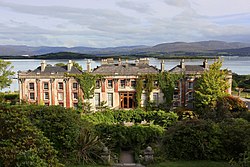| Bantry House | |
|---|---|
 Bantry House and Bantry Bay | |
| General information | |
| Architectural style | Queen Anne with Georgian and Victorian additions [1] |
| Town or city | Bantry |
| Country | Ireland |
| Coordinates | 51°40′37″N9°27′54″W / 51.677°N 9.465°W |
| Completed | c.1710 (original house) c.1820 (additions) c.1845 (wings) [1] |
| Website | |
| bantryhouse.com | |
Bantry House is a historic house with gardens in Bantry, County Cork, Ireland. Originally built in the early 18th century, it has been owned and occupied by the White family (formerly Earls of Bantry) since the mid-18th century. Opened to the public since the 1940s, the house, estate and gardens are a tourist destination in West Cork. [2]


